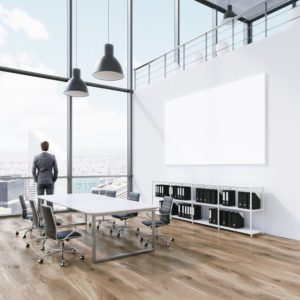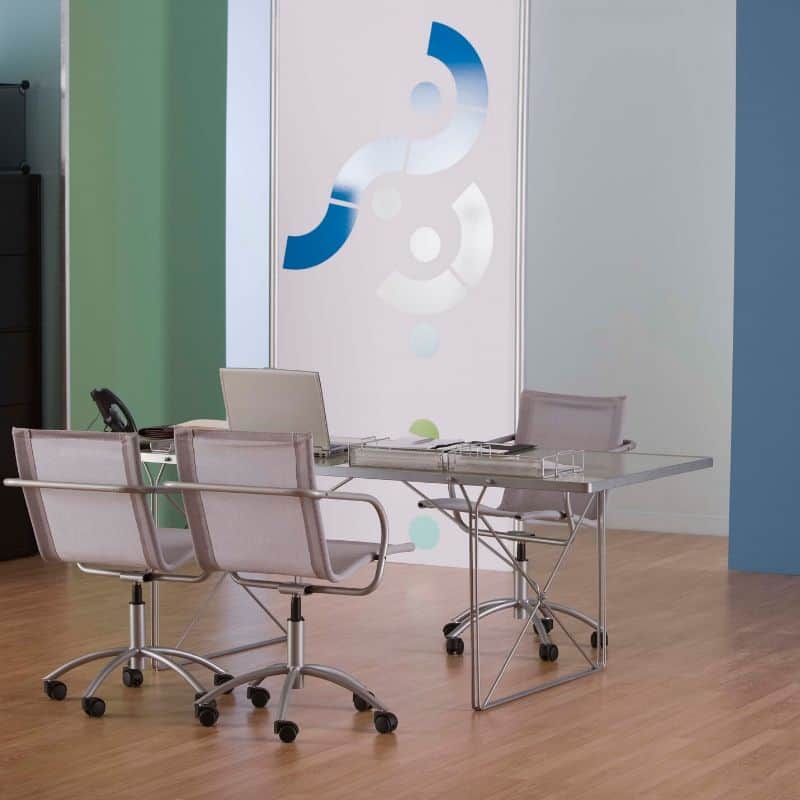What Is a
Huddle Room?
Get a complete look at what makes a huddle room an effective part of the modern office experience
Huddle room design is all well and good, but first the big question…
What is a Huddle Room?
A huddle room is a small, informal collaborative space where teams can work together on shared projects in person, via teleconferencing, or both. The space functions as a meeting room in many practical ways, except they are designed for smaller, more intimate groups of collaborators (usually 2 to 6 people).
As a concept, huddle rooms came to be following the widespread adoption of open offices. Without offices – or even cubicles – there was nowhere for colleagues to gather and work. Meeting rooms were too large and bogged down with red tape for quick, ad hoc discussions or check-ins. Public spaces lacked the quiet necessary to communicate effectively, and they didn’t offer the privacy of a small workspace.
Out of the need for some middle ground between a meeting room and the open office space, the huddle room was born.
A huddle room is a small, informal collaborative space where teams can work together on shared projects in person, via teleconferencing, or both.
Why Do You Need a Huddle Room?
A huddle room is designed to be a versatile space where people can meet to talk or collaborate on tasks. They combine a number of features that many organizations need.
Informal Flexibility
A huddle room is an informal space designed for a variety of functions. It’s an ideal place to have a quick chat with a co-worker or classmate. Or it provides a shared space for tasks that require teamwork. Or it is a quiet spot to hold a video conference or sales call.
A good huddle room will be set up with all these functions in mind – and more – making them perfect for organizations that expect creativity.
Clearer Communication
Open offices may break down walls between colleagues, but they put up walls of other kinds. Barriers to communication appear in the form of ambient noise, lack of communication technology, or simply lack of privacy.
Adding huddle rooms to an organization help people connect in a more meaningful way and break down the invisible obstacles between teammates.

Smaller and Less Expensive
Why have one large conference room when you could have four small huddle rooms? It’s rare to fill a meeting room anyways, so what’s the point? By breaking down the space into smaller compartments, your organization can maximize usable space and allow more work to get done at the scale that it’s completed.
And instead of massive, enterprise-sized screens, projectors, and tables, you can scale down the tech required for each huddle room. Keep simple, flexible, and efficient.
Remote Connectivity
In the Digital Age, it’s increasingly common to work with off-site colleagues. Your teammate could be just down the street, in the next city over, or on the other side of the planet. To effectively communicate, you’ll need a quiet, private space to do so. But why take up a whole meeting room for just one-on-one or a small video conference?
A fully connected huddle room acts as the connected workplace’s phone booth. Even at a great distance, smaller spaces have a way of bringing people together.
Faster, More Efficient Meetings
Smaller spaces mean smaller groups, which streamlines meetings already. Then add in the easy connectivity that is the hallmark of huddle rooms, and you’re reducing the time talking and increasing the time doing.
And thanks to the ad hoc nature of huddle rooms, even getting into the meeting is quicker. No more red tape booking a space or waiting for a meeting room to be available. Just grab the first free huddle space and get down to business.

Huddle room design is actually pretty simple. But the challenge with simple things is doing it well and not adding unnecessary fluff. This is doubly true when it comes to huddle rooms because their function is to simply facilitate the discussion, task, or decision at hand. Then it’s done.
So whether you’re building your own huddle space, working with an interior designer, or hiring a solutions provider, make sure to KISS (Keep It Simple, Stupid).
Here’s what you’ll need to create a special huddle room:
- Small space idea for a tight team of 2 to 6 people
- Shared seating around a central table or work surface
- A shared display with video capabilities
- Some division or partition from the surrounding space
Limit Your Palletes
While it’s fine to use vibrant color and aesthetically pleasing materials, avoid making the space busy by limiting how much you add. This doesn’t mean that a huddle space needs to be drab. Quite the opposite, a pleasing space to be in will inspire its occupants. Just resist the urge to be extra.
Use Modular Fixtures
Any object in the room from furniture to tech should be modular and adjustable to accommodate any team’s workflow. Each team is unique as an individual, and you’ll want to provide them with a space that will suit their needs.
Allow Environmental Control
In addition to modular objects in the space, huddle rooms should also have fully adjustable environmental controls. They should have their own air conditioning and heat, adjustable lighting, and maybe even noise-canceling technology depending on the surrounding environment.
Separate It
A huddle room is a cure to the problems of open office floor plans. Making yet another open space defeats the purpose. Make sure that even if you aren’t using an actual “room” with walls and a door that there is a clear division between the huddle space and the rest of the working space.
Huddle Room Technology
As a product of the Digital Age, huddle rooms rely on technology to streamline meetings and work. And given that the point of the huddle room is to communicate with teammates both near and far, a certain amount of connectivity is also required.
And the options are going to be nearly endless, so keep in mind to KISS everything. Keep integration in mind, too. There’s no point in getting the best-quality everything if it doesn’t play nice with the rest of the gadgets in your workspace.
Here’s a list of the minimum you’re going to need, along with links to one of our favorites in each category:
If you’re going to take our recommendations, then that’s pretty much all you’re going to need. But if you’re going to mix and match, then here are the functions you’re going to have to include to get the most of your huddles.
Shared Display
This means that everyone can potentially connect to a central shared display, usually a larger-than-average screen either mounted on a wall or placed in a central location. And that shared display should absolutely be a touch screen to enable annotation and elaboration on the fly.
Wired for Sound
Ideally, you would want a decent sound system built into your display. But if it’s not included – or you want to upgrade sound quality – you’ll have to get some sort of external system. Ideally, you’d want a wireless connection so that everyone can share their device easily.
Video
Video chat has revolutionized remote work and it goes a long way towards connecting remote team members. You’ll want to be sure that there is some sort of camera for video conferencing.
Microphones
At an absolute minimum, you need to have a microphone in your huddle room both to record meetings for minutes or records and to make outbound calls. And if your video camera doesn’t include a microphone, you’ll need it for video conferencing as well.

Huddle Room Furniture
While a completely empty meeting space has a certain Zen minimalist appeal, it’s not practical for most organizations’ needs. At a minimum, a huddle room should contain somewhere to sit and a work surface. Ideally, there should also be a whiteboard or its equivalent.
From these base requirements, however, you will find a functionally infinite number of options. Virtually any seating arrangement made up of whatever tables and chairs are available could work. It will ultimately be up to your needs of the space both functionally and aesthetically that define what furniture you use. But here are a few considerations anyways.
And regardless of your aesthetic, it’s important to consider the needs of the people who will be using the huddle room first and appearance second. These are spaces to be used after all.
Seating Arrangements
Huddle rooms and huddle spaces are arranged in a huge number of ways. Some organizations opt for fixed benches, even restaurant-like booths. Others may use glass partitions around high tables with bar stools. Some huddle rooms are more like living rooms where low sofas and armchairs gather around a low table and central display. And then there are extremely basic versions with a small table, six chairs, and a whiteboard.
Tables
Again, make sure that the table is appropriate to the type of work being done. A design firm or creative agency might need larger spaces for a chaotic splash of materials, sketches, and mobile devices. Meanwhile, a publisher or think tank might only need small tables to facilitate discussion. And keep in mind that the table is likely to be the largest object in the room, so you’ll have to strike a balance between the compactness required of huddle spaces and enough space to accomplish the necessary tasks.

Chairs
There’s a reason why chairs are listed after tables: seating should be around the central workspace. A table is absolutely necessary. Chairs are not. (It’s also an option to use standing-desk style tables with no seating at all.) So whatever chairs you choose, make sure they work with the main theme of the huddle room. And again, strike a balance in comfort. Too comfortable, and teams may nod off during meetings. Too uncomfortable and no one will use the space. Find that Goldilocks zone for your seating.
Whiteboard
Regardless of whether you opt for a display capable of digital whiteboarding, there’s something to be said about actually writing something on a real physical object. And as long as there are fresh markers and a clean rag nearby, a tangible writing surface is immune to blackouts, WiFi issues, and other technological calamities. Your important work will continue uninterrupted.

Learn More About Huddle Rooms
No Results Found
The page you requested could not be found. Try refining your search, or use the navigation above to locate the post.

